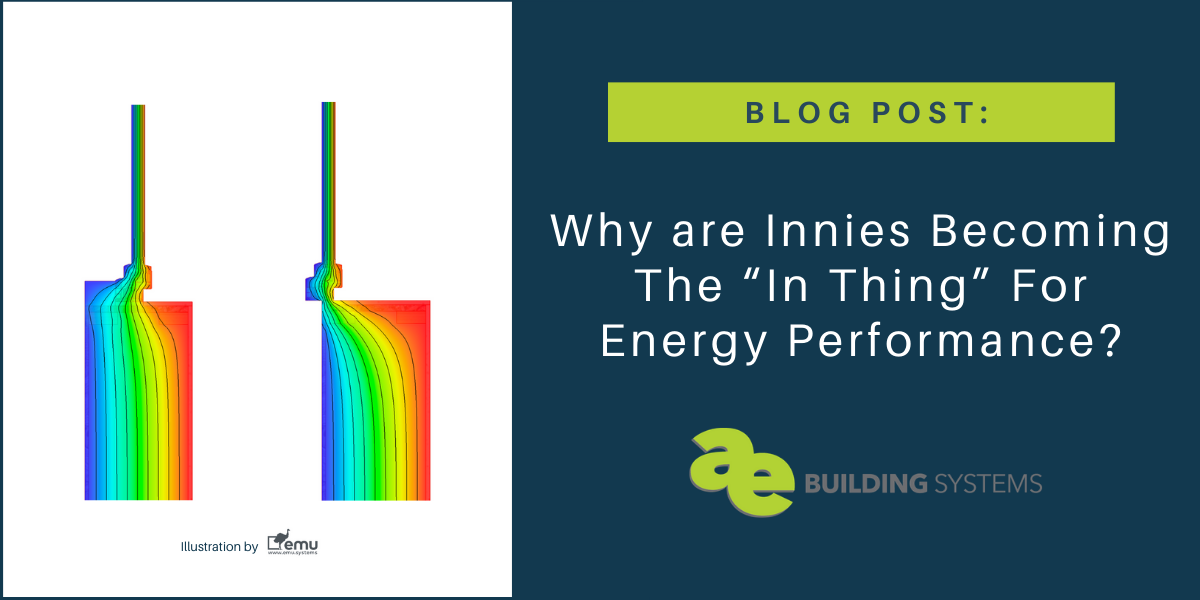Your cart is currently empty!

Why are Innies Becoming The “In Thing” For Energy Performance?
One of the big debates in construction sounds a lot like we’re talking about belly buttons, but we’re actually talking about window construction: innie vs. outie! In construction this great debate has been going on for some years and it can be confusing to know what the right solution is for your project. Each style has been used in various ways over the years, but if you’re like us, and concerned about thermal performance and energy savings, you will want to pay attention.
The Basics of Innie & Outie Window Construction
Outie Window Construction:
Outie windows are constructed with the glazing of the window set flush to the outside of the wall assembly – typically with a “nail fin.” These are the types of windows most Americans are used to seeing in a home.
Pros:
- Easier Installation: Installed with nailing flanges to the outer face of the wall.
- Deeper interior sill: Interior sill leaves a small ledge.
- Simple Drainage: No exterior window sill to be concerned with.
- Conventional looking: This is what most people are accustomed to, know, and understand. Many homeowners like to have a little sill to place plants or other decorations.
- Easier for continuous insulation: When windows are set on the outside, things line up more, and the water and control layer is the face of the continuous insulation.
Cons:
- More thermal bridging: Since window assembly is on the exterior shell of the home, there are more thermal considerations to deal with. Often ThermalBuck is a good solution for this, but the simple fact of the location means higher heat loss and greater thermal bridging.
- More Instability: Since the window isn’t fully framed into the wall itself, and is instead screwed on with flanges, the window often just “sits in” the space, rather than is fully part of the wall like its counterpart.
- Wind-washing: Because the window is to the exterior, wind will cool it down in winter and warm it in summer more readily.
Innie Window Construction
Innie Windows are a window construction style where the glazing of the window is set at the middle of the wall. Many people enjoy the overall look of Innie Windows, but don’t even realize just how efficient they can be! Take a look at some of the pros and cons of Innie Window assemblies:
Pros:
- Weather Protection: Since Innie Windows are not on the direct outer surface of a wall, the window is protected more from rain and wind.
- Improved Thermal Performance: Since the glazing is within the wall’s depth, the window at large is more insulated from the thermal envelope of the building.
- Greater Support: Innie Windows are secured and supported by a full frame, rather than just screws on a flange.
- Solar shading: Recessed glazing provides greater shade from the sun throughout the day.
- Better thermal performance: The glazing being within the wall’s depth keeps the glazing within the insulated thermal envelope
- Better for Passive House design: In Passive House design, every little bit of energy performance matters; ultimately Innie designs can help the overall performance of a home!
- Aesthetic: Some architects and homeowners prefer the look of an inset window.
- Wind protection: from “Wind-washing”
Cons:
- Greater Complexity: An Innie Window is much more complex to install, as it creates concerns not only for the window itself, but for the exterior sill and surround.
- Require thick wall assemblies: Innies are not very common in 2×4 or 2×6 construction. Instead, you’ll find them in Double Stud designs, or Phoenix Haus wall assemblies.
- Exterior Sill Detailing Needs: Requires a solid weather-resistant exterior sill and special considerations for this design.
It’s easy to see why Innie Windows are becoming a more popular choice for builders. Windows are a hot spot for thermal bridging and while there are a lot of things we can do with insulation construction, supporting products, and the window product itself, we also know that if you’re going for energy savings, the placement of the window itself makes a big difference. It may only be a few inches in, but Innie Windows can provide a solid improvement in energy performance, especially if you’re going for a Passive House certification where every bit of help may make a difference between getting certified or not.
Still not sure if Innie Windows are right for you? Our team is ready to help you understand if they’re applicable for your project, and if so, how you can best approach the project and make sure everyone is on board.

Leave a Reply